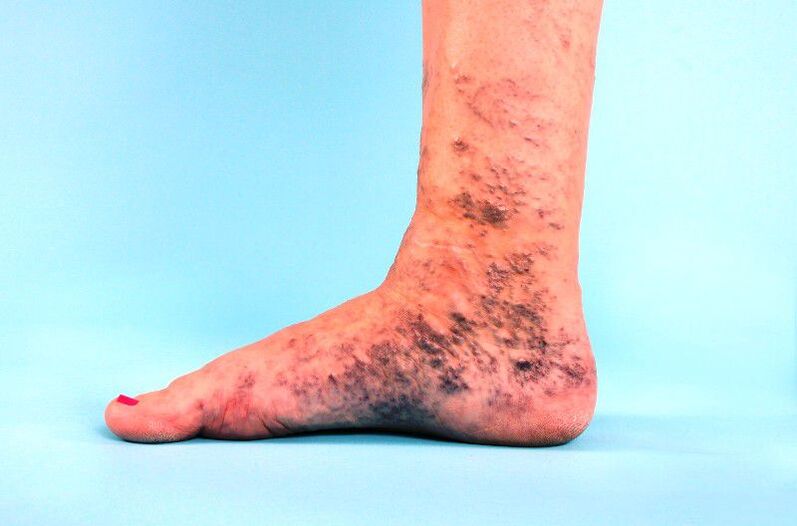
Varicose veins in the legs are one of the most common diseases appearing in a large number of women of any age. Men also suffer from this, but much less frequently. With such symptoms, very rarely do people turn immediately to medical professionals. Everyone is trying to self-medicate, considering all of these as temporary manifestations. Varicose veins of the leg are often confused simply with an overloaded body, which is tired from daily work and a heavy schedule.
The peculiarity of varicose veins in the legs is such that treatment helps especially well only in the early stages of the disease, but not in the latter, when there are more and more manifestations every day. If everything is left to chance, then in the extreme stages a surgical operation is required. The disease gradually progresses. Especially if it goes along with venous insufficiency.
With varicose veins of the lower extremities, the symptoms disappear with pathological enlargement and hemodynamic disturbances. Venous valves do not work well. Over time, all of this worsens with thrombophlebitis, phlebothrombosis, and pulmonary thromboembolism.
The onset of the disease
The first symptoms of varicose veins in the legs are accompanied by improper action of the venous valves, leading to blood reflux. Endothelial cells receive a signal from slowed blood flow. Leukocytes are installed on them. Thus, the inflammatory process begins in the vascular walls, which pass along the bed of veins. The inflammatory process catalyzes disorders of the venous walls.
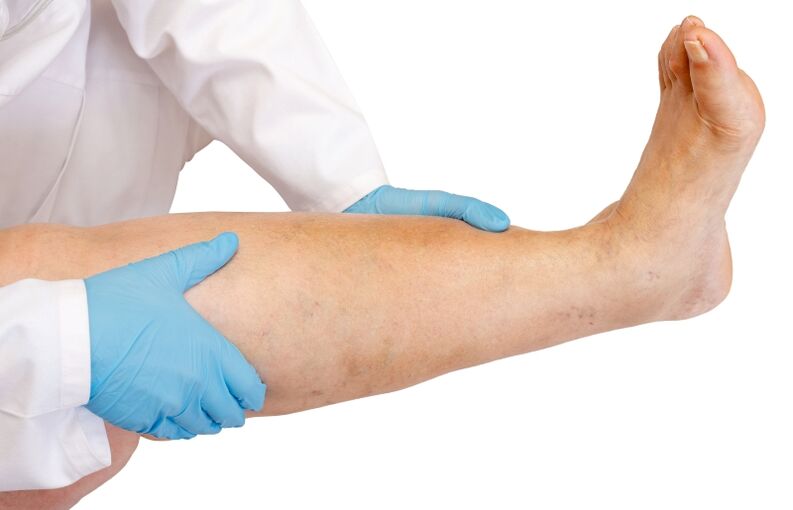
All the pressure is stronger in the venous valve system. To begin with, the lesion is visible in the areas with the highest load - the large and small perforating vessels and saphenous veins. After that, the channel begins to fill the overrun. From this derives the redistribution of venous blood to the walls. And below, more often than not, there are many more of them. All this volume smoothly reaches the deep veins, where everything lies in its immediate environment. Venous dilation and insufficiency of valve sections occur.
Causes
Phlebologists identify a number of reasons that cause pathology in the work of the venous system. This may be due to a genetic predisposition and due to the totality of unpleasant effects on the human body. Hereditary characteristics are manifested not only in women but also in men. The disease can pass inside for a long period, but does not appear outside in any way. After that, due to some external catalyst, a failure in the venous valves leads to the first appearances on the skin.
The following important reasons provoke disease:
- age parameters;
- hormone failure;
- diabetes;
- permanent constipation;
- periods after surgery or injury;
- alcohol and tobacco addiction;
- hypercoagulability and excess weight;
- period of birth and pregnancy;
- underwear that squeezes individual body parts;
- long idle time and high workloads;
- congenital defects of the circulatory system;
- life in inadequate conditions due to climate.
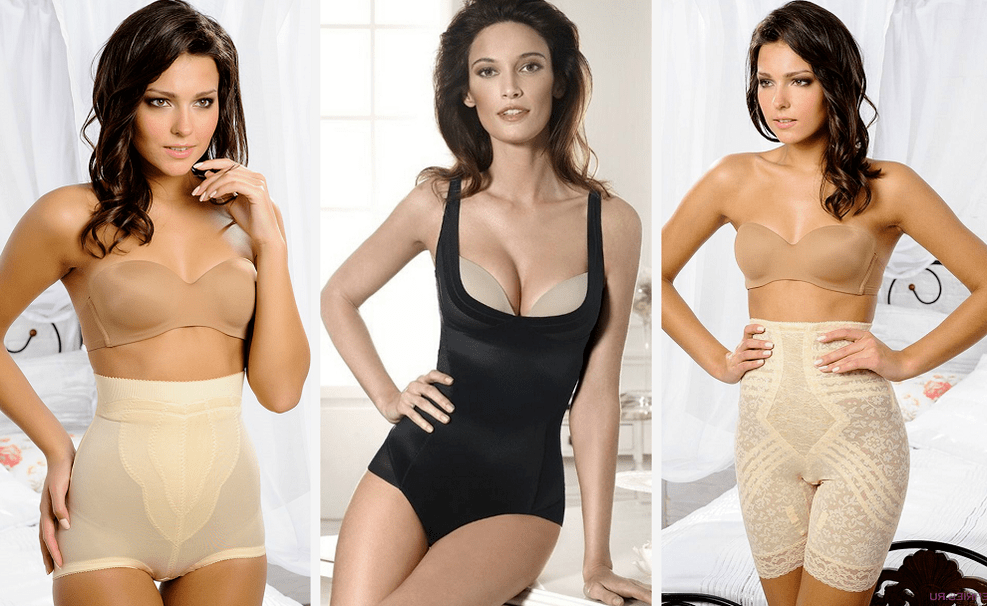
Symptoms
Diseases of the veins of the legs are not simple blue spots with long paths in the shape of a tree. They are also often called vascular stars. This is far from the first stage, and even the name of such a phenomenon is - veins with intradermal varicose veins. As we wrote earlier, this situation can occur due to a number of factors, including pregnant girls. The human body is gradually being rebuilt due to the influence of hormones. It is not dangerous, except for embarrassment due to external manifestations. Young ladies do not like to see that they have blue stain on the outside. Such appearances of veins with lower varicose veins can be removed with cosmetic devices, adjusting your diet, switching to the recommended dietary products.
The bluish mesh most often tells the patient that he has a harmless type of varicose veins of the lower extremities.
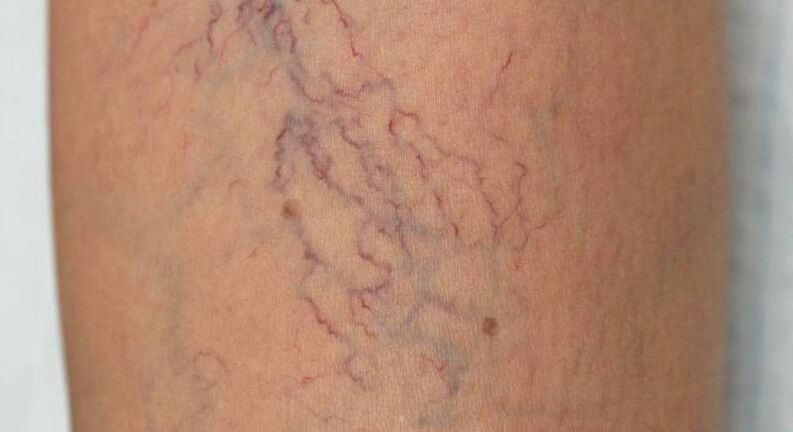
Human health does not suffer from this in any way, but it is still uncomfortable to live with such a problem for a long time. Experts advise to contact specialized cosmetology clinics, where you can be prescribed a course of treatment with herbs, creams, gels and oils. This is a combination of traditional medicine and classical clinical research.
If any bumps or bumps are already prominent, then an urgent need to consult a doctor. There can be no self-medication here. If there is pain in the leg with varicose veins, symptoms that you find difficult to define, then contact therapists. In general, it is very difficult to completely remove varicose veins of the lower extremities, the symptoms of photography and treatment testify to this. In advanced situations, you should even turn to the surgical department for help, where you will undergo an operation. The onset of varicose veins in the legs is characterized by an aggravation in the limbs, edema and some cramps. All these symptoms of varicose veins tell us directly that you have only the case that is treated only under the supervision of a doctor.
If you notice redness on the skin, feel discomfort when walking, see congested vascular walls, feel a rise in temperature, then this is already a serious disease called thrombophlebitis.
There is already a significant risk of losing health. If you do not pay attention to all these signs of varicose enlargement for a long time, then even a few deaths occur annually. Usually, with a disease with current symptoms, the patient is immediately hospitalized for long-term treatment. Even if you have only noticed one symptom, then there is no need to wait for the weather near the sea. Urgently to the clinic, and there will already be more visible.
Distribution
In 2000, a 4-point classification of varicose veins in the leg was proposed:
- Dilated veins within the skin of the segmental type. Venous discharges are not visible.
- Enlarged veins of a segmental nature with reflux.
- Varicose veins with reflux throughout the area of the lower extremities.
- Varicose veins with varicose reflux with penetration into the deep veins.
Moreover, medical staff identify not only increasing pathological changes starting from the foot, but also descending - varicose veins start from the mouth of the saphenous vein.
When determining the type of disease, they also look at the level of venous insufficiency.
Zero - the disease is absent in humans, the first is the aggravation of the foot, the second is the appearance of edema, the third is persistent edema, eczema, increased pigmentation, lipodermatosclerosis, the fourth is the formation of trophic ulcers.
diagnostic
At first, the method of examination by a phlebologist is purely external, that is, the doctor examines the external changes in the foot. With a high degree of probability, already at this stage, a rough diagnosis is determined, but it never ends there. Then they perform a series of research and diagnostic procedures of a general nature:
- Blood test;
- X-Ray;
- rheovasography and duplex scanning;
- Doppler ultrasound and plethysmography.
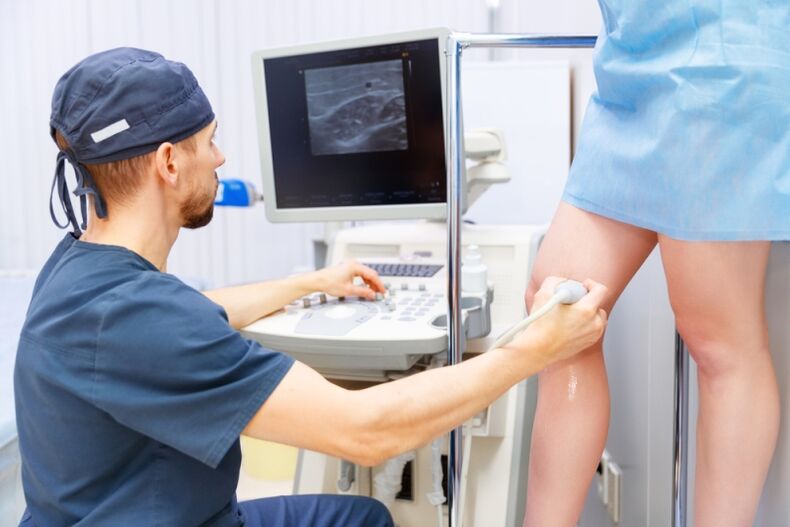
Treatment
Varicose veins of the lower extremities are easily curable in the early stages. The whole procedure works to normalize blood circulation, blood flow and prevent any complications. All this helps to improve the overall condition of the body. Therapeutic techniques are divided into two types.
Conservative therapy is most often used when the first signs of varicose veins appear in the legs. The skin is affected, but these are not some pronounced segments. The person continues to live a normal life. The disease does not radically affect anything except the psychological state.
The surgical method is recommended when the disease appears in large areas with clear lines, small lumps and ulcers. The recovery method often begins with minimally invasive procedures, but complete surgery sometimes comes to the rescue when the case is extremely neglected.
Conservative technicians
A complex course is described to the patient:
- Specialists are trying to get rid of all the possible risks of disease progression. Varicose veins in the legs are examined by a phlebologist, who can place the patient on clinical examination.
- They start fighting adinamine. If there is no thrombosis, then you need to actively engage in sports, evenly loading your body, training the lower limbs vigorously. Intensity is already being discussed with the physiotherapist. Most often they are forced to swim, run, ride a bike. It is recommended to wear sports underwear with extra compression. Before exercising, you should keep your legs in an upright position for a few minutes. Patients are not advised to engage in contact sports: powerful martial arts, football, hockey. For improved foot fixation, elastic bandages are used.
- Compression knitwear and elastic bandages are needed not only in sports fields. They are trying to treat the symptoms of varicose veins of the lower extremities. When used properly, venous circulation should be improved. This type of treatment is often prescribed for a limited time.
- Taking medication. The course of taking the medication is prescribed for all stages of the development of varicose veins. Unintentional use of disease pills can only lead to aggravation of the situation. The patient can get rid of any bright manifestations on the legs within a month, if you follow the doctor's instructions. All drugs prescribed belong to different groups of drugs that have an anti-inflammatory effect and are associated with angioprotectants, phlebotonics, desogregants or anticoagulants.
- Physiotherapy is always included in the complex of counteracting the symptoms of varicose veins of the legs. All of them affect, first of all, the restoration of the tone of the venous walls, the drainage of lymph and the improvement of blood circulation. A number of medications have been prescribed, from magnetic therapy and laser to pneumocompression and hyperbaric oxygenation. Often these are oxygen and mineral baths. If there are no contraindications and side effects, then the patient is prescribed massage activities. Moreover, sometimes they can even be performed at home. They are also treated with hirudotherapy and apitherapy.
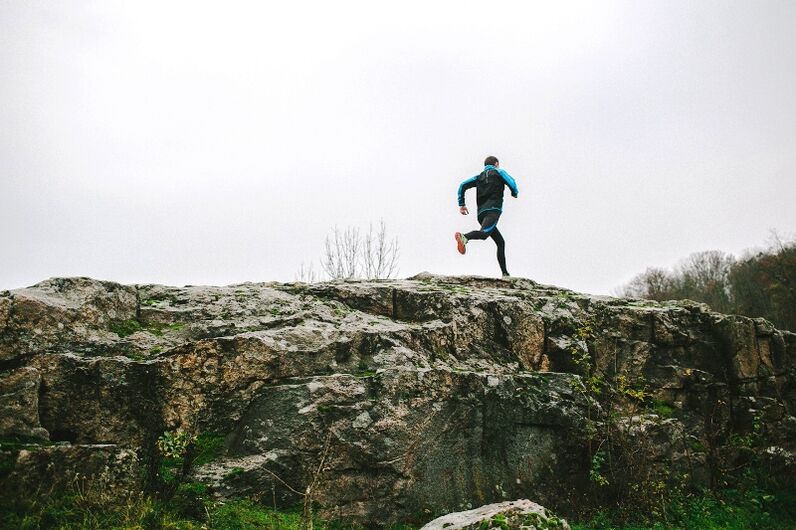
Surgical techniques
Venous-type diseases sometimes need to be treated by surgeons, when all the symptoms of the disease accumulate and negatively affect each other, and the stage has long since passed into the last quarter. They try to fight with a minimally invasive method. This is sclerotherapy with the introduction of certain substances that affect the walls of blood vessels. This is microsclerotherapy that acts directly on the spider veins. This is microthermocagulation, working on a thin electrode, eliminating all bright external manifestations. These are laser endovasal coagulation and radiofrequency ablation of varicose veins - they all act on the affected areas of the veins, providing a thermal effect. All this is necessary in order not to prescribe drastic measures and to carry out a real operation. There are already special methods of a new kind, which began to be applied only from the late 90s.
Transluminal phlebectomy: a thin probe is inserted into the lumen of the diseased vein. Thanks to this, the doctor exercises control over the entire operation. An anesthetic is administered. All affected areas are removed by aspiration.
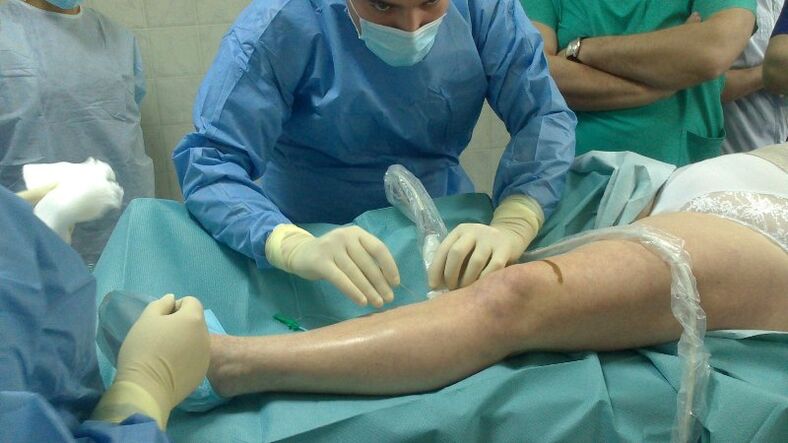
Endoscopic dissection: Perforated veins are connected using endoscopic equipment.
There are also special surgeries to preserve the veins. They are intended to restore the functioning of the venous valves. There is a fixation of specialized structures that impede the progression of a pathological nature. Sometimes hemodynamic surgeries are used to relieve the affected veins by directing the venous flows in other directions. Relapses in these situations are common. Do not visit baths, saunas in the postoperative period, walk less often and do not lift heavy things.
Phlebologist opinion:
The use of compression stockings with elastic bandage is necessary not only for sports. With their help, the initial signs of varicose veins are treated. If this is done properly, there is an improvement in venous blood circulation. Often, these treatments are prescribed for an unlimited period. Medications can be prescribed at any stage when varicose veins develop. If pills are used insanely to cure an illness, the situation can get worse. After a month, patients can remove various manifestations on the surface of the feet, when he begins to follow the doctor's recommendations. Medications achieve an effect in which the inflammation disappears. These are angioprotectants, phlebotonics, disinfectants or anticoagulants.
reviews
- The first answer, a woman, 39 years old: "The signs of varicose veins of the legs were realized about a year ago. This is my hereditary disease in my mother's line. Often, at the same time, vascular arteriosclerosis occurs. InIn this case, in my case, folk methods did not help relieve the pain, although I also had a vein with initial varicose veins. I started to deal with prophylaxis very late. all affected areas. He will prescribe a specialized course of treatment that relieved me of all the unpleasant external manifestations in about a month. we can say with certainty that all women should go to the doctor immediately. "All these grandma methods. Only phlebologists will help you find medicine. They know everything about varicose vein problems. "
- Second thought, a woman, 52 years old: "Despite the fact that she was constantly monitoring her health, varicose veins nevertheless appeared. I always turn to the doctors who attend simply for the initial examination and diagnosis. The whole course lasted 3-4"I was already engaged in purely preventive and restorative procedures. Now a little sport, proper nutrition, yes, in general, that's all. The disease has receded and, hopefully, it will never return. "























